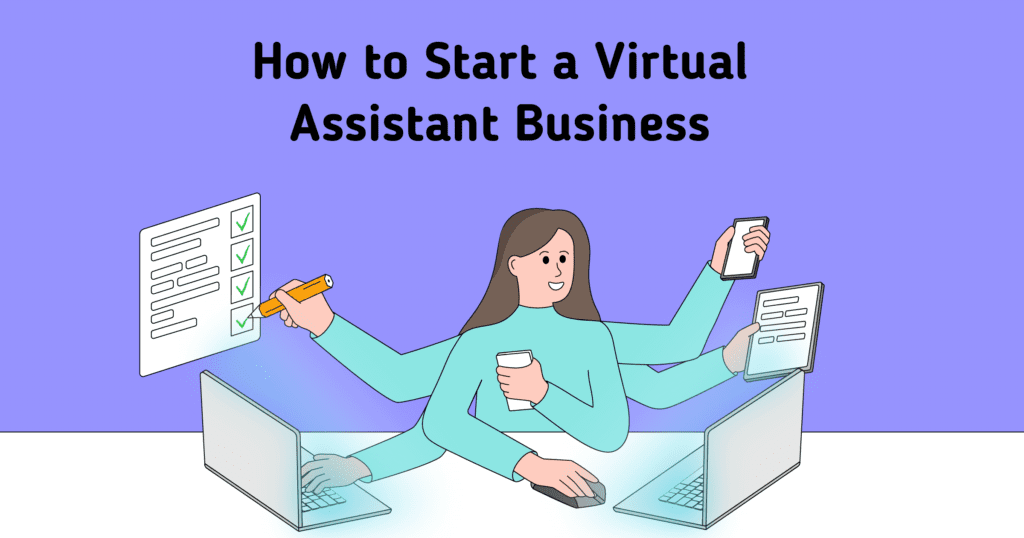Are you tired of the daily commute, office politics, and rigid schedules that come with traditional employment? Do you crave more freedom and flexibility in your career? If so, it’s time to explore how to start a virtual assistant business.
A virtual assistant business epitomizes the modern approach to service-based entrepreneurship. It provides invaluable administrative, creative, and technical support to individuals and companies, all conducted remotely. These adept professionals, known as virtual assistants, offer diverse services tailored to meet the unique needs of their clients.
From managing calendars and scheduling appointments to handling email correspondence and maintaining social media presence, virtual assistants excel in many tasks essential to the smooth functioning of businesses in today’s digital age.
Understanding the Role of a Virtual Assistant

In today’s fast-paced digital world, virtual assistants (VAs) are like superheroes for anyone needing help. They’re skilled professionals who offer all sorts of support—like organizing stuff, being creative, and fixing tech issues—without ever having to be in the same place as their clients. They use technology to work together smoothly from wherever they are.
Types of Services Offered by Virtual Assistants
Virtual assistants offer a comprehensive suite of services tailored to meet the diverse needs of their clients. These services include, but are not limited to:
- Administrative Support: VAs excel in managing calendars, scheduling appointments, handling email correspondence, and organizing documents. They serve as the backbone of administrative operations, ensuring efficiency and organization.
- Creative Services: VAs offer innovative solutions to elevate their client’s online presence, from content creation and graphic design to website maintenance and branding. Their artistic flair and attention to detail help businesses stand out in a crowded digital marketplace.
- Technical Assistance: VAs possess expertise in various technical areas, including website development, software implementation, and IT support. They troubleshoot technical issues, optimize digital workflows, and ensure that clients harness the full potential of technology to achieve their goals.
- Marketing and Social Media Management: VAs play a crucial role in devising and implementing marketing strategies, managing social media accounts, and engaging with audiences to enhance brand visibility and drive growth. Their strategic insights and hands-on approach help businesses navigate the ever-evolving digital marketing landscape.
- Research and Analysis: VAs conduct in-depth research, gather data, and provide valuable insights to support informed decision-making. Whether it’s market research, competitor analysis, or trend forecasting, they equip clients with the knowledge to stay ahead of the curve.
Starting a Virtual Assistant Business in 8 Easy Steps

Starting a virtual assistant business is an exciting journey that offers freedom, flexibility, and endless opportunities. In just eight simple steps, you will know how to start a virtual assistant business from home and turn your skills and passion into a thriving business venture. Begin by defining your niche and identifying the services you’ll offer. Next, set up your home office and equip yourself with the necessary tools and technology. Establish your online presence through a professional website and social media profiles.
1- Make a Solid Business Plan
Creating a well-thought-out business plan serves as your roadmap to success. It outlines your goals, target market, competition analysis, marketing strategies, financial projections, and operational plans. Your virtual assistant business plan should include:
- Provide a concise overview of your virtual assistant business concept, mission, and the unique attributes that will set you apart from the competition.
- Identify your target market, analyze industry trends, and understand client needs and preferences. This insight will help you tailor your services to meet market demands effectively.
- Study existing virtual assistant businesses, identify their strengths and weaknesses, and determine how you can differentiate yourself. Highlighting your unique selling points will give you a competitive edge.
- Develop a robust marketing strategy to attract clients, establish your brand, and build strong client relationships. This might include online marketing, networking, and leveraging social media platforms to increase visibility and engagement.
- Create a comprehensive financial forecast, including startup costs, monthly expenses, revenue projections, and profitability analysis. This will help you plan your finances and ensure sustainability.
- Implement a system for assessing, diagnosing, and prioritizing business problems or issues. This essential part of your management plan will help you address challenges promptly and keep your business on track.
2- Building an Online Presence
Start by creating a professional website that serves as the central hub of your online presence. This site should be well-designed, easy to navigate, and mobile-friendly. Include detailed information about your services, showcasing what you offer and how to meet clients’ needs.
Consider using online advertising to boost your online presence. Google Ads and social media advertising can target specific demographics and interests, helping you reach potential clients searching for your services. Online advertising can be a cost-effective way to increase your visibility and attract new business quickly.
3- Choose Your Business Structure and Management Strategy
Choosing the proper business structure and management approach is crucial for the foundation and growth of your virtual assistant business. The business structure affects your legal obligations, taxes, and the way you operate. Typical structures include sole proprietorship, partnership, limited liability company (LLC), and corporation. Each has advantages and disadvantages, so it’s essential to research and select the one that best fits your needs and goals.
4- Setting Your Rates and Creating Packages
Determining your rates and creating service packages is crucial in establishing a successful business. Start by researching industry standards to understand the typical pricing for similar services in your market.
Consider your experience level, the complexity of your services, and the value you provide to clients. It’s essential to strike a balance between being competitive and ensuring your rates reflect the quality of your work.
Once you have a baseline rate, consider offering tiered packages that cater to different client needs and budgets. For example, a basic package might include essential services at a lower cost, while premium packages offer comprehensive solutions with additional features.
Clearly outline what each package includes to help clients easily understand their options and choose the one that best suits their needs. Providing packages simplifies the decision-making process for clients and allows you to upsell additional services, ultimately increasing your revenue potential.
5- Networking and Building Relationships
Networking and building relationships are fundamental to growing your business and expanding your professional reach. Start by attending industry events, conferences, and local business meetups to meet potential clients, collaborators, and mentors.
Engage actively in online forums, social media groups, and professional networks like LinkedIn to connect with like-minded individuals and stay updated on industry trends. When networking, focus on building genuine connections rather than simply promoting your services. Show interest in others’ work, offer support, and share your expertise where relevant. Follow up with new contacts to maintain and nurture these relationships over time.
6- Choosing a Business Name
Selecting a name for your business with a virtual assistant business name generator is an important step that can significantly impact your brand’s identity and recognition. Aim for a name that is memorable and reflects your company values. Consider the nature of your industry, your unique experience, and what differentiates you from your competitors.
A well-chosen name should resonate with your target audience and convey the essence of your business. For extra inspiration and ideas, use a business name generator. These tools can help you brainstorm and refine potential names until you find the perfect fit for your brand. Remember, your business name is the foundation of your brand, so take the time to choose one that will leave a lasting impression.
7- Tools and Software for Virtual Assistants
Virtual assistants can significantly enhance their productivity and efficiency by leveraging various tools and software. Project management tools like Trello, Asana, and Monday.com help organize tasks, set deadlines, and track progress.
Platforms such as Slack, Microsoft Teams, and Zoom are essential for communicating with clients and team members.
Time management and scheduling tools like Calendly, Toggl, and Clockify help manage appointments and track work hours effectively. Document creation and collaboration can be streamlined using Google Workspace or Microsoft Office 365, which offer shared access to documents, spreadsheets, and presentations. For financial management, tools like QuickBooks and FreshBooks provide invoicing, expense tracking, and financial reporting capabilities.
8- Securing Legal Compliance and Necessary Permits
Before launching your virtual assistant business, you must comply with legal requirements by registering with the appropriate authorities and obtaining necessary permits and licenses.
The specific licenses and permits you need will vary depending on your location and the services you offer. This may include acquiring local business licenses, professional certifications, or permits specific to the virtual assistant industry.
Adhering to these regulations demonstrates your commitment to operating your business ethically and professionally. It also ensures you can provide your clients with reliable and reputable services. Stay informed about any updates or changes in regulations to maintain compliance and uphold the integrity of your virtual assistant business.
How Much Does it Cost to Start a Virtual Assistant Business
Here are some potential expenses you may encounter when starting a virtual assistant business:
- Cost of purchasing or upgrading a reliable computer/laptop to handle your workload.
- Expenses for purchasing necessary software such as project management tools, communication platforms (e.g., Slack, Zoom), and productivity software (e.g., Microsoft Office).
- Costs associated with domain registration, website hosting, and potentially hiring a web developer/designer to create a professional website.
- Budget for promoting your business through social media ads, PPC campaigns, content marketing, and SEO efforts.
- Fees for online courses, workshops, or certifications to enhance your skills as a virtual assistant.
- Expenses for registering your business, obtaining licenses or permits, and securing professional liability insurance.
- Budget for purchasing necessary office supplies such as stationery, printer ink, and postage.
- Costs for setting up a home office, including furniture, ergonomic equipment (e.g., chair, desk), and lighting.
- Additional expenses for increased internet usage, electricity, and other utilities associated with running your business from home.
- Fees for joining industry-specific associations or organizations that offer networking opportunities and resources for virtual assistants.
- Budget for unforeseen expenses or miscellaneous items such as client gifts, travel expenses (if applicable), and ongoing professional development materials.
Conclusion
Starting a virtual assistant business from home offers a flexible and rewarding opportunity to leverage your skills and expertise while serving clients remotely. By assessing your strengths, conducting thorough market research, and developing a solid business plan, you can position yourself for success in this growing industry. Establishing a professional online presence, defining your pricing structure, and implementing effective marketing strategies are essential to attracting clients and growing your business.











